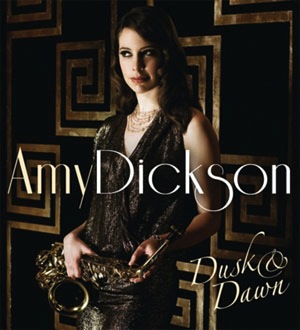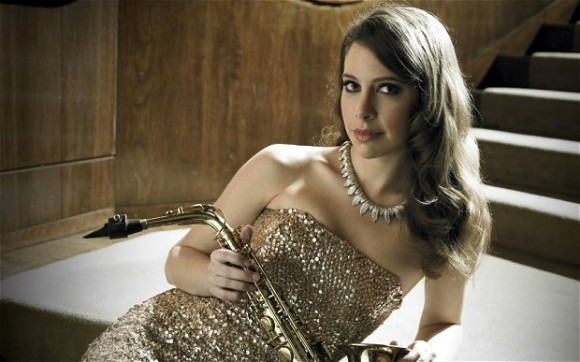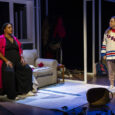Whenever I hear the saxophone used in classical orchestral music – after years of digging the instrument in jazz and rock with all its attendant growls, snarls, bleeds and honks – it sounds like a completely different instrument to its earthier-music sibling. Its tone is lighter and more burnished, yet with the faint ‘oriental’ tang of, say, the cor anglais.
The classical approach to the saxophone of course has much to do with it. In jazz, the aim is to go for as ‘vocal’ an attack as possible – throaty, acid-edged and happy to throw in the occasional ‘ugly’ or ‘wrong’ note (which of course are neither ugly nor wrong in jazz). The classical way is one of very pure, rich tone with any embellishments subtle and perfectly held.
The classical repertoire for saxophone is also extremely slight, despite being bumped up by sax adaptations of existing pieces for other instruments.
Australian saxophonist – now based in London – Amy Dickson’s new album, Dusk and Dawn, takes the smart tack of drawing material from various sources – classical and non-classical – to allowing her beautiful playing to be the star here.
 Sony has also aimed to widen Dickson’s audience – and hopefully that of the classical sax – by theming Dusk and Dawn as a mood piece: sensual and sultry, and evocative of cinema and sophistication. The inclusion of works by Kern, Nino Rota, Hoagy Carmichael and even Tom Waits – as well as cover shots of Dickson in evening dress (Armani) against Art Deco – broadcast this loud and clear.
Sony has also aimed to widen Dickson’s audience – and hopefully that of the classical sax – by theming Dusk and Dawn as a mood piece: sensual and sultry, and evocative of cinema and sophistication. The inclusion of works by Kern, Nino Rota, Hoagy Carmichael and even Tom Waits – as well as cover shots of Dickson in evening dress (Armani) against Art Deco – broadcast this loud and clear.
That of course, is just smart marketing – it does not take a thing away from the beauty of Dickson’s playing. The nominal ‘classical’ pieces here – works by Walton, Debussy, Fauré and Bellini – are equally chosen for their ‘cinematic’ moods. The opener, Fauré’s duskily plaintive “Pavane” (which I won’t admit here that I first encountered on The Jethro Tull Christmas Album) sets the mood of Dusk and Dawn – one of rich sentiment, human scale emotion and the tone-poetry of concert hall and movie house.
Jerome Kern’s “Smoke Gets In Your Eyes” is perfect – the spiralling tone of Dickson’s alto suits the winding melody: you can see the blue smoke drifting upwards from a cigarette in a slim, gloved hand. Equally, of the ‘jazz’ pieces here, Carmichael’s “Skylark” – over a swooning string arrangement by Nan Schwartz – shows how much feeling Dickson can conjure with little but a pearlescent tone and effortless technique-beyond-technique.
Harry Warren’s 1934 blues-ballad “I Only Have Eyes For You” suffers slightly from the inclusion of a jazz rhythm section, making the unadorned saxophone sound a little flat against the backbeat.
Dickson shines, though, on Tom Waits’ “In The Neighbourhood”, its sparse arrangement, now devoid of Wait’s picaresque lyric, bringing out the warm churchy melody – like many Randy Newman tunes, sounding like an old Shaker hymn you just can’t quite place.
The piece which to me perfectly and delightfully expresses the lushly romantic brief of Dusk and Dawn is Nino Rota’s “La Strada”. The theme from Fellini’s 1954 semi-surrealist film is one of Rota’s loveliest and Amy Dickson’s flute-like lightness – over Chris Walden’s orchestration – voices the yearning and pathos of the melody far far better than any overwrought, ‘vocal’ approach possibly could. Stunningly beautiful stuff.
Amy Dickson is a champion of contemporary composers and has recorded works by Pärt, Nyman and Glass. That she is equally at home playing Chopin’s Nocturne No.2, Tom Waits and “Skylark” shows she is a complete musician who loves music and making music. Simple as that.
But what do I know? I listen to The Jethro Tull Christmas Album. Make up your own mind, and bask in some unabashed beauty along the way. Have a listen to Amy Dickson’s Dusk and Dawn.
Dusk and Dawn was released on Sony Classical on October 4, 2013.




